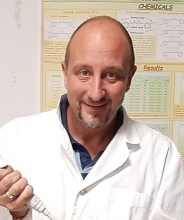Luca Nardo is an experimental physicist specialized in electronic-state transition spectroscopy applied to the study of biological, biomedical, and pharmacological systems, and to the characterization of new materials. He has obtained a PhD in Physics in July 2008 and is presently working on a tenure-track research fellowship at the Department of Science and High Technology of the University of Insubria. His research activity is mainly based on the implementation of advanced fluorescence techniques, such as time-correlated single-photon counting (TCSPC), confocal microscopy, fluorescence correlation spectroscopy and fluorescence resonance energy transfer (FRET), applied both on molecular ensembles and at the single-molecule level. Nardo has also professional experience in biomedical optics, laser physics and detector physics. Since his MD, he has been engaged on the elucidation of biochemical interactions between biomacromolecules and small ligands, particularly aimed at the characterization of tentative pharmacological active principles. During his PhD he focused on another “topos” of his scientific production: conformational analysis of DNA by means of Time-Resolved FRET experiments. The ability to determine conformational variations with sub-nanometre resolution has been exploited to: (i) characterize the binding mode of ligands to the double helix; (ii) investigate epigenetic markers like promotorial G-quadruplex and methyl-cytosines; (iii) type polymorphic genes. In this last application, Nardo has taken advantage of the chance of working on sub-picomolar concentrated samples, intrinsically warranted by TCSPC, achieving the typing of non-amplified and non-purified DNA. Another line of his research activity consists in assisting pharmacologists in the rational-design of both drug substances and molecular as well as supramolecular systems for their delivery, and on ex-post evaluation of their photostability, chemical reactivity and biological activity through elucidation of their excited-state dynamics via TCSPC. In the last years, the characterization of novel luminescent polymeric materials, organic an organo-metallic, has also achieved a primary importance in Nardo’s activity, with applications in both theranostics and the sensing of atmospheric and water pollutants.
NARDO LUCA

Sito web:
Email
Phone
031 238 6272,031 238 6273
